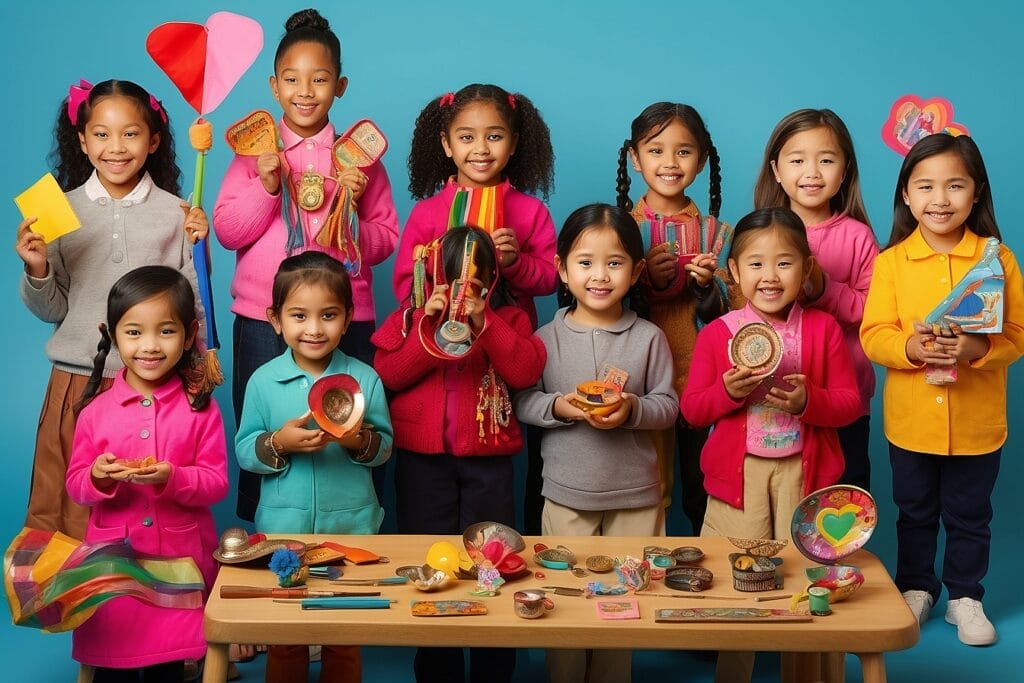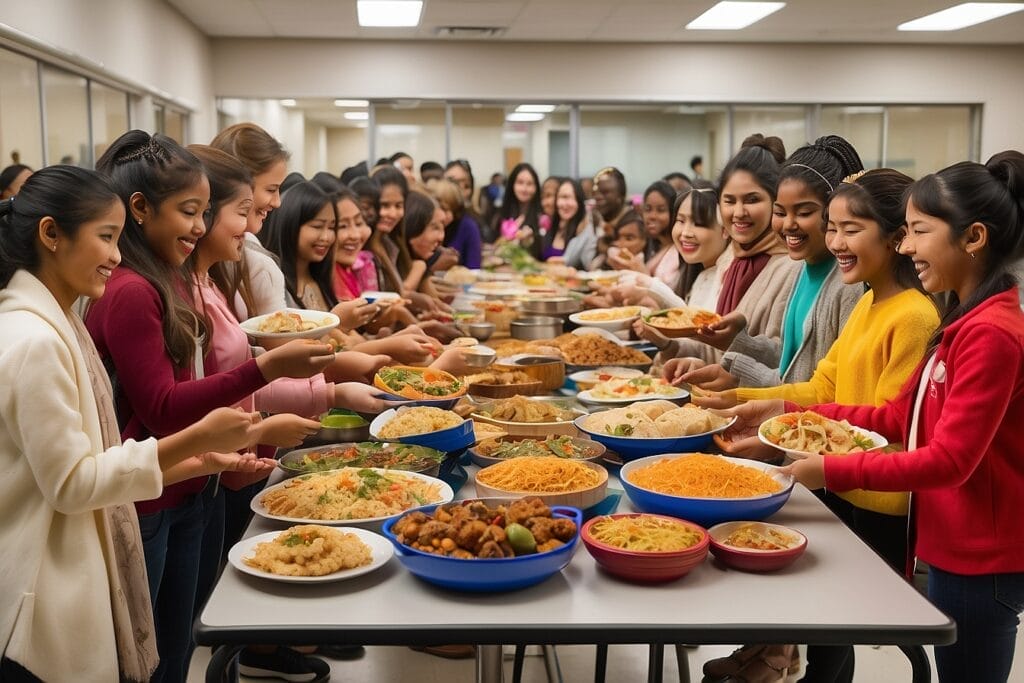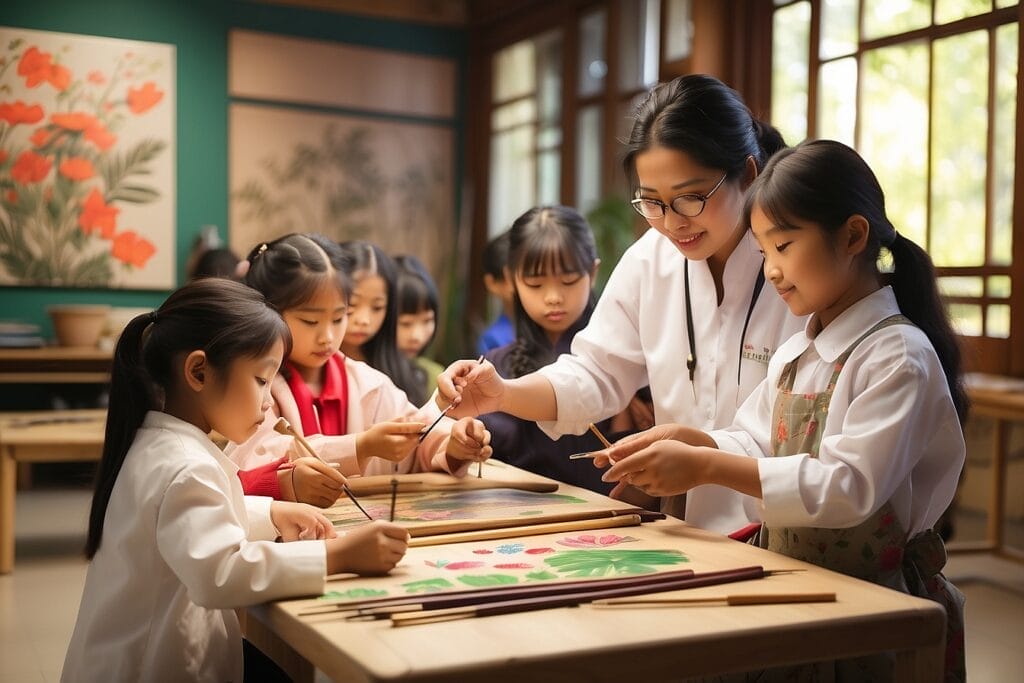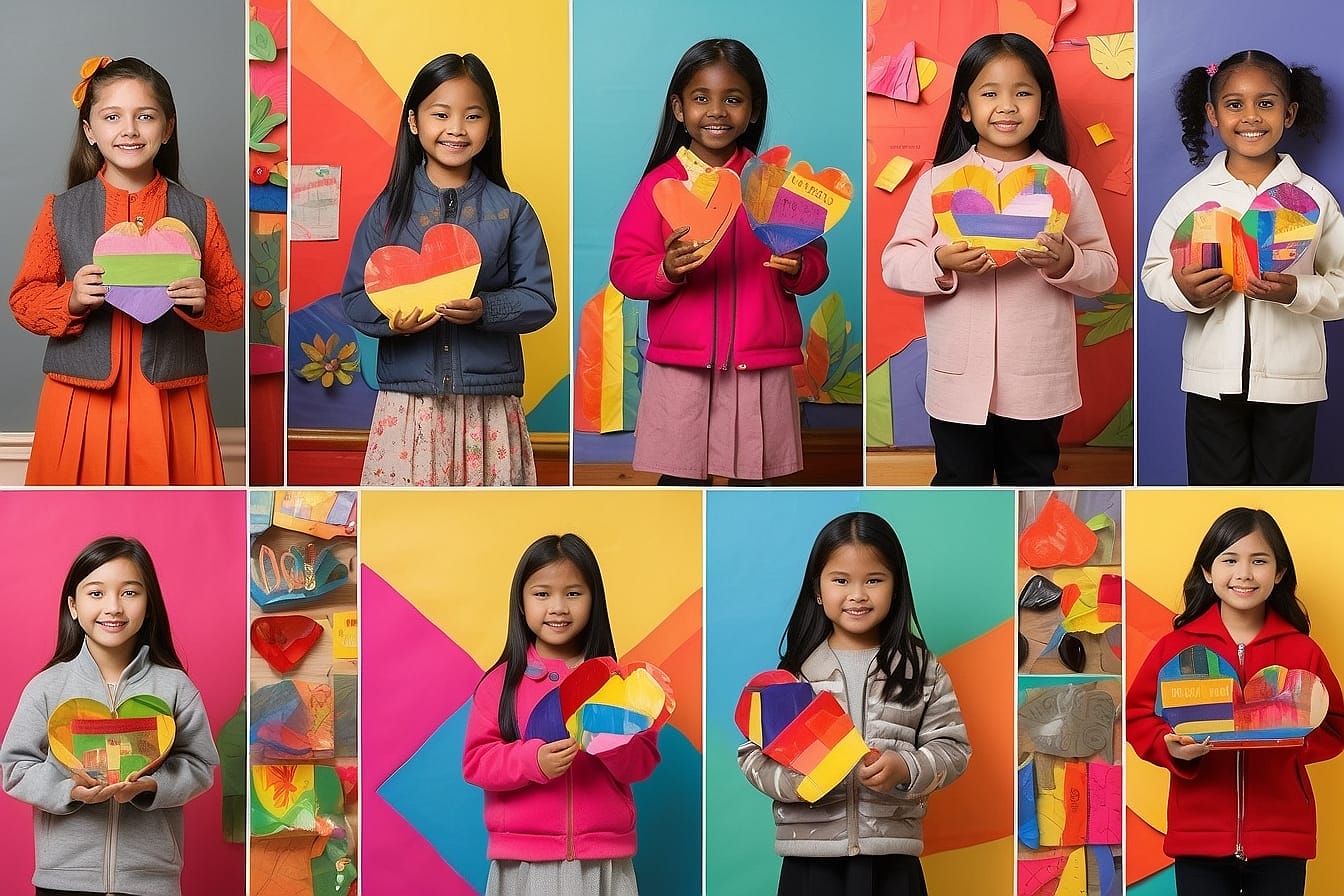Introduction
In a colorful classroom, where children draw and laugh, cultural awareness activities are important for elementary students. Our goal as educators is to create an environment where all colors, sounds, and tastes are valued. Teaching cultural diversity in the classroom is like celebrating the uniqueness of young minds. These activities will help your students get excited about the different skin colors and cultures in your class. They will also learn to appreciate and respect our beautiful diversity.
In this introduction, we start a journey to discover cultural awareness activities. These activities encourage respect and understanding among students and are also enjoyable. Educators can create an inclusive classroom by doing these activities. This helps every child feel represented and appreciated for their culture.
Let’s explore the power of teaching diversity through activities that go beyond textbooks. We can embrace the vibrant realities of people from different countries, skin tones, and walks of life.
Key Takeaways
- Cultural awareness activities have a profound impact on developing empathy in students. These activities help people learn about and value their peers from different cultures.
- Embrace different cultures to improve social skills, teamwork, critical thinking, and problem-solving abilities. Your students are learning life skills that will be useful outside of school, not facts.
- Discover enjoyable customs like Show and Tell and International Food Day. Students create collages and learn about their cultural heritage in art lessons.
- Join in the magic of cultural storytelling with activities like Story Swap and the Cultural Book Club. Find out how these stories can create a feeling of togetherness in your diverse classroom.
- Experience the thrill of Global Games and Sports. Students learn traditional game rules and cultural nuances. Celebrate holidays with crafts that show global celebrations from around the world.
- Learn how to include cultural activities in your lesson plans to make a meaningful impact. Discover the importance of accurate resources that represent diverse cultures. Learn to collaborate with local community organizations and use technology for virtual learning.
In essence, this exploration transcends the ordinary. We want to make a welcoming place where students embrace diverse cultures and become global citizens. Jump in and see your classroom become a lively place of learning and understanding.

Benefits of Cultural Awareness Activities for Elementary Students
Elementary students need to learn about different cultures in today’s world. It helps them become well-rounded and caring individuals. Students can learn about different cultures through inclusive and engaging activities.
This promotes understanding and appreciation for diversity. These cultural awareness activities have many benefits for development. Let’s explore them together.
Development of Empathy and Understanding towards Others
Adding cultural awareness activities to the elementary curriculum has a major advantage. It helps build empathy. When college students find out about different cultures, they start to respect variations and become more compassionate.
Children can learn about cultures using creating a collage or taking a digital discipline experience. They can step into the shoes of others and understand different cultures.
Enhanced Social Skills and Teamwork Abilities
Taking part in fun class activities that celebrate diverse cultures can improve teamwork and social skills. Students learn to work together and talk by doing art projects and making newsletters. These activities help students connect and work together, skills they’ll use in life.
Encouragement of Problem-Solving and Critical Thinking
Cultural recognition activities act as catalysts for important questioning and problem-solving. When students read books about different cultures, they learn and think. To help students think about the world and solve problems, include diversity activities in the curriculum. They also analyze the fee of tackling challenges.
Recognition of Multiculturalism and Diversity
Cultural cognizance sports purpose is to foster appreciation for diversity and multiculturalism. Students can learn about other cultures using participating in events that showcase their cuisine, traditions, and tunes. This appreciation doesn’t manifest in school, but lasts an entire life, even into maturity.
A Comprehensive Table of Benefits of Cultural Awareness Activities for Elementary Students
| Benefits of Cultural Awareness Activities for Elementary Students |
|---|
| 1. Enhanced Social Skills |
| – Develop empathy and understanding towards diverse cultures |
| – Foster positive communication and collaboration |
| – Encourage teamwork and cooperation among students |
| 2. Expanded Global Perspective |
| – Promote an appreciation for different customs and traditions |
| – Broaden awareness of global issues and interconnectedness |
| – Instill a sense of global citizenship and responsibility |
| 3. Improved Academic Performance |
| – Enhance critical thinking skills through exposure to varied cultures |
| – Increase cognitive flexibility and adaptability |
| – Boost creativity by exploring diverse perspectives |
| 4. Positive Identity Development |
| – Strengthen self-esteem and confidence through cultural pride |
| – Reduce stereotypes and biases, promoting positive self-image |
| – Foster a sense of belonging and acceptance in diverse environments |
| 5. Cultural Sensitivity and Respect |
| – Teach tolerance and respect for differences |
| – Reduce prejudice and discrimination |
| – Build a foundation for a culturally sensitive and inclusive society |
| 6. Language Acquisition |
| – Introduce students to new languages and linguistic diversity |
| – Improve language learning skills through cultural context |
| – Develop a love for languages and communication diversity |
| 7. Community Engagement |
| – Strengthen connections between schools and local communities |
| – Encourage involvement in community events and celebrations |
| – Promote a sense of shared responsibility and unity |
| 8. Preparation for the Future |
| – Equip students with skills needed for a diverse workplace |
| – Enhance adaptability in an ever-converting international landscape |
| – Foster an attitude of continuous learning and openness to new ideas |
| 9. Emotional Sturdiness |
| – Develop emotional awareness and regulation skills |
| – Encourage students to recognize and appreciate diverse emotions |
| – Improve interpersonal relationships and conflict resolution |
| 10. Parental Involvement |
| – Facilitate family engagement in cultural awareness activities |
| – Strengthen the school-home connection |
| – Create a supportive and inclusive school community |

Fun and Engaging Cultural Awareness Activities for Elementary Students
A. Sharing Traditions: Activities to Promote Inclusivity
1. Show and Tell: Embracing Cultural Identity
Have fun: Bring an object that represents your culture to share with classmates, like show-and-tell. This not only promotes inclusivity but also helps students connect with their roots.
2. International Food Day: A Culinary Journey
Kids can take part in diversity activities by bringing a dish from their culture. Not only does it make lunch enjoyable, but it also helps us explore different global cuisines.
B. Exploring Cultural Art: Igniting Creativity with Diversity
1. Collage Creation: Symbolism Across Cultures
Students create collages using pictures and symbols from different cultures. This fosters creativity and sparks discussions about the cultural elements’ significance.
2. Traditional Art Lessons: Local Artists Bridging Cultures
Students can learn by inviting artists from different cultures to enhance their experience. Students learn traditional art and explore different artistic expressions.
C. Cultural Storytelling: Encouraging Diversity Through Narratives
1. Story Swap: Connecting Through Folktales
Students take turns sharing traditional folktales, legends, or personal stories from their cultures. By promoting this, we can learn more about the different stories that shape our world. The atmosphere is vibrant.
2. Cultural Book Club: Exploring Multicultural Literature
Reading books from different cultures and discussing them can help people value literature and see various viewpoints. This inclusive approach encourages students to explore worlds beyond their own.
D. Global Games and Sports: Bridging Traditions through Play
1. Cultural Olympics: A Mini World Tour
To get students involved, plan a mini Olympics with games and sports from different countries. This activity gets students moving and teaches them about different cultures.
2. Traditional Game Exchange: Learning Through Play
Students must research and teach traditional games from their cultures. This turns the classroom into a lively place for interactive learning.
E. Celebrating Festivals and Holidays: Embracing Cultural Richness
1. Cultural Calendar: Year-Round Learning
Teach students approximately one-of-a-kind cultural festivals and holidays that show up over the 12 months. To understand the beauty and significance of various celebrations, take part in similar activities.
2. Festive Crafts: Creating Cultural Artifacts
Celebrate and learn! Make piñatas for Cinco de Mayo and Chinese lanterns for the Lunar New Year. Students can create cultural artifacts.
Ways to Include Activities Developing Cultural Awareness in the Classroom
Working together with Cultural Institutions and Local Community Organizations
If you need numerous cultures in your lecture room, reach out to nearby community companies and cultural establishments. This gives you a danger to learn from one-of-a-kind viewpoints and make new connections.
There are many methods to sell cultural knowledge. One way is to have guest lectures by community leaders. Another way is to have joint projects that connect the classroom and the community.
Utilizing Technology for Global Connections
In an era of advanced technology, our classrooms are not confined by four walls. Using technology and online learning lets students connect with peers worldwide. This now not simplest broadens their horizons but also instills an experience of interconnectedness.
Students find out about the extraordinary styles of humans inside the international through using technology. They do video calls, work on projects, and do virtual exchanges.
Providing Accurate Representation through Resources and Materials
In an inclusive classroom, it’s important to have resources that represent diverse cultures. Books and pictures should show diverse backgrounds in detail. This helps break cultural biases and encourages students to value their own culture.
Encouraging Open and Respectful Discussions
Creating an inclusive classroom involves more than activities. Having a space for open and respectful discussions about cultural differences is crucial. It is important to make space for students to share their thoughts, ask questions, and talk. This helps people understand and question cultural stereotypes and biases.
Engaging Activities to Promote Cultural Understanding
1. Cultural Heritage Show and Tell
Encourage students to share artifacts or stories from their cultural heritage. Sharing experiences helps naturally foster diversity and cultural understanding.
2. World Map Exploration
Make your classroom more global by including activities like drawing on a map. Use it to show where your students come from. This represents the diverse backgrounds within the class.
3. Multilingual Storytime
Organizing a multilingual storytime can expose students to the beauty of different languages.
4. Cooking Adventures
Food is a language everyone understands. Cooking lets us try different cultures’ yummy dishes. In the kitchen, you can learn about different cultures while making sushi or baking bread.

Accepting Diversity: An Individual Path
During my training adventure, I discovered how vital it is to embrace distinctive cultures. Allow me to share a poignant story that illuminated the profound impact of fostering inclusivity in my classroom.
I introduced a cultural awareness activity during a normal school day. The activity focused on sharing traditions. Each student brought something to share their culture and explain why it mattered. I was excited to see the personal artifacts, but I didn’t expect to hear so many stories.
One student, Lily, timid and reserved, brought forth a small, designed wooden box. As she opened it, revealing an array of aromatic spices, she began to narrate the tale behind each. These were spices from her family’s homeland, a place rich in traditions and customs. Lily shared her story and a strong bond formed in the room, despite our differences.
The students had a magical conversation about their roots, customs, and unique qualities. The classroom felt like a small world. It embraced differences instead of ignoring them. It was a lesson that went beyond textbooks and resonated in the hearts and minds of every student.
This experience showed the need for an environment that goes beyond acknowledging diversity. Cultural awareness activities aren’t checkboxes on a curriculum. They’re important catalysts for empathy, understanding, and unity.
As back on this journey, I remember that education is more than teaching facts. It’s about helping people become global citizens. We want our students to value and enjoy the varied experiences and cultures of people. We help create a future where we value diversity and include everyone by doing this. We also appreciate the beauty of our shared human experiences.
FAQs:
How can elementary school instructors lay cultural diversity sports for kids that not simplest have fun variety but also interact with students in exploring and appreciating the richness of many cultures?
To create a culturally numerous classroom, essential faculty teachers can lay out attractive sports that no longer most effectively celebrate range but also foster an appreciation for the richness of many cultures.
Incorporating fun activities like drawing images of culturally diverse characters, playing track from diverse elements of the arena, and even cooking traditional cultural foods can help college students study and admire exclusive cultures in a fun manner.
What are a few innovative ways to infuse cultural attention into the school room via a range of sports for children, making sure that the activities now not handiest celebrate variety but also actively engage students in the getting-to-know method?
Infusing cultural attention into the classroom via revolutionary diversity sports is an extremely good manner for college students to learn whilst having fun. Teachers can use age-suitable substances and sports, which include storytelling, playing music, or even introducing affiliate links to assets that show off one-of-a-kind cultures.
This now not simplest represents range in the international however additionally guarantees that scholars are actively engaged within the studying technique.
Could you share sensible examples of ways educators can create colorful learning surroundings with the aid of incorporating sports that remember range and sell cultural attention among fundamental college students, encouraging them to discover and recognize many cultures?
Educators can create a colorful learning environment by way of incorporating activities that celebrate the range and promote cultural recognition among simple college students. For example, students can share something unique about their subculture, bringing variety into the classroom.
Teachers with two decades of enjoy running with various populations suggest introducing excursion celebrations like Eid or Ramadan, allowing students to find out about and appreciate cultural practices in an amusing and age-appropriate way.
In what methods can simple school instructors foster cultural expertise via arms-on sports for children, aiming to have a good time range and interact with students in meaningful experiences that show off the splendor of many cultures?
To foster cultural expertise, essential faculty teachers can put into effect arms-on activities that celebrate variety and interact with college students in meaningful studies. Choosing sports in which students draw pics representing their very own subculture or those from special backgrounds facilitates youngsters to understand and admire the individuality of every lifestyle.
By incorporating socio-financial and bilingual factors, educators can help students apprehend and recognize the range of their study rooms.
How do diversity activities for youngsters contribute to building an experience of cultural awareness in essential college students, and what techniques can educators rent to ensure these sports now not only have fun diversity but also efficiently engage students within the exploration of different cultures?
Diversity activities for kids contribute significantly to building a sense of cultural awareness in elementary students. Teachers can employ strategies such as playing music from different countries, encouraging students to share information about their culture, and using a critical eye to explore cultural uniqueness.
By providing age-appropriate materials that represent various cultures, educators help children enjoy learning about diversity in a fun and culturally diverse way, ultimately fostering a deeper understanding and respect for each other.
How can essential instructors integrate “celebrate diversity in the lecture room” activities to foster an extra-inclusive studying environment?
Essential instructors can seamlessly integrate “celebrate diversity in the classroom” activities by incorporating fun ways for students to share and present their cultural backgrounds. Encourage students to choose and prepare activity ideas that showcase the uniqueness of their cultures, promoting cultural diversity in your classroom.
What are a few creative ways to celebrate cultural diversity to students into the curriculum, selling a deeper expertise of different cultures?
To celebrate cultural diversity in the curriculum, educators can ask students to share something special about their own culture. Incorporate diversity by pairing students from different backgrounds to explore similarities and differences.
Another fun way to celebrate is by using multicultural books on holidays and traditions, making the learning experience enjoyable and educational for diverse cultures represented in your class.
Could you share 15 cultural diversity activities that now not handiest entertain but additionally educate younger newbies approximately the importance of embracing cultural differences?
Sharing 15 cultural diversity activities for elementary students can be both entertaining and educational. Have students prepare presentations about different cultures, incorporating items that represent their heritage.
Utilize printable resources and multicultural children’s books to introduce children to recognize languages other than English. This excellent way of learning promotes a culturally diverse classroom.
In what methods can educators leverage “way to have a good time cultural variety” to encourage open discussions and sell tolerance amongst simple college students?
Educators can leverage “way to celebrate cultural diversity” to promote open discussions and tolerance by encouraging students to choose one culture’s music, represented in the classroom, for indoor recess.
This unique approach fosters an environment where children of the world become more aware of the variety of cultures, creating an inclusive space that goes beyond traditional learning experiences.
How do “diversity in the classroom” initiatives contribute to shaping well-rounded individuals, and what role do cultural diversity activities play in achieving this goal?
Diversity in the school room” initiatives contribute to shaping properly-rounded individuals through creating mastering experiences that consist of books, activities, and displays reflecting extraordinary cultures.
By incorporating variety on your study room, college students explore and have a good time the wealthy tapestry of cultures represented, encouraging them to turn out to be greater aware and accepting of the world’s unique cultures.
Conclusion
Education includes cultural awareness activities that leave a lasting impact on students. As we draw the curtain on this exploration, let’s reflect on the key harmonies that have emerged:
- Embracing diversity in the classroom can transform our journey and bring unity. We watched a pretty tapestry being made. It looked beautiful because of the different threads.
- Cultural awareness activities have benefits that go beyond lesson plans. Empathy, social skills, and critical thinking are not for school, but for life. They help students in a world that values diversity.
- We built meaningful cultural conversations by sharing stories, exploring traditions, and playing games. These conversations also happen outside of school. They help society understand and accept one another.
- We learned how to teach with cultural awareness by using practical strategies. These strategies include community collaborations and virtual learning. These tactics are tools that help us create inclusive, rich classrooms. We can use them to empower ourselves.
Educators around the world, it’s time to act and embrace both tradition and innovation.
Embrace the Challenge: Push yourself to do more than usual. Fill your classrooms with the joy of embracing cultural differences.
🤝 Encourage unity by embracing diverse perspectives, traditions, and stories in our environment.
Let’s keep talking about cultural awareness. It’s important for education and creating a more tolerant world.
In conclusion, we should be architects of change. We should shape not only knowledgeable minds but also caring hearts. Let’s make classrooms that are safe places to learn and understand different cultures. The seeds of cultural awareness we plant now will grow into a better future. Now it’s our turn to create a lasting cultural impact by orchestrating a symphony.

Sarah Andrews’ work on relationships is informed by a breadth of experience and a strong interest in human nature. Sarah, who holds a Psychology degree and has a good eye for nuances, delves into the complexity of communication and emotion, delivering insightful insights for readers seeking personal growth and emotional pleasure. Sarah hopes that her empathic approach and insightful suggestions will motivate readers to understand themselves and their relationships better.
